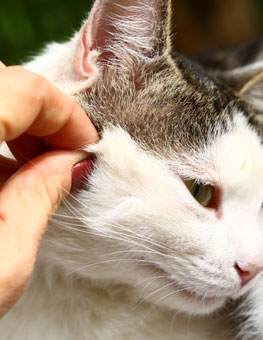Warmer weather means more outdoor time for you and your pet. It also means the possibility of coming across tick-infested territory. To ensure your pet stays tick-free, we recommend using preventative flea and tick protection, plus checking your pet regularly where ticks love to feed.
Under the Collar
Ticks can live in relative safety underneath your pet's collar, harness, or item of clothing, where they're out of biting and nibbling range, and protected from most scratches. What’s more, because it's a moist, low-light environment, and has thicker and fuller hair than other areas, under the collar is an ideal spot for ticks to latch on and get comfortable.
Under the Tail
Pet owners sometimes overlook the underside of a dog's or cat's tail when doing a tick inspection. However, this is often a tick's favorite area to hide and feed. Commonly found at the base of the tail, where hair is thick, moist, and harder for pets to reach, ticks can go undetected without a thorough inspection.

In the Groin Area
Ticks on pets - Removing tick from dog paw. Learn how to find ticks on dogs.
Your pet's toes are easy to latch onto and vulnerable to tick bites.
As uncomfortable as it sounds, checking your pet's genital region for ticks is a good idea if they've spent any time outdoors. As one of the more moist, dark, and secluded areas on your pet, ticks can thrive around your pet's groin and perianal (buttocks) areas. Just be sure you don’t mistake moles, skin tags, or nipples for a feasting tick before you decide to remove it.
Between the Toes
Ticks often attach to your pet as they walk on the ground, which makes your pet's toes easy to latch onto and vulnerable to tick bites. Usually found between the toes or footpad, ticks can burrow into the deepest part of your pet's feet, and may go unnoticed. When checking this area, be sure to spread their toes apart and inspect the rest of their paws thoroughly for the parasitic critters.
Under the Legs
Armpits, elbows, and hind legs are easy pickings for a hungry tick, who often feeds in these moist areas unbothered and undetected. Fortunately, these regions tend to have less fur, which makes it easier for pet owners to isolate a tick's location.
Ticks on pets - Removing a tick from underneath a dogs leg. Learn where to find ticks on dogs.
Armpits, elbows, and hind legs are easy pickings for a hungry tick.
A quick visual check while pulling aside your pet’s fur should expose these nasty hitchhikers.
On the Eyelids
Skin tags around the eyelids are somewhat normal for pets and can often be confused for ticks; however, the opposite is also true.
When looking for ticks on your dog or cat, pay close attention to the color of any bumps or nodules located around their eyes. If it's brown or reddish in color, and has legs or other arachnid-like features, then it's probably a tick. More often than not, a skin tag is the same color as your pet's skin, and won’t continue to swell like an engorged tick.
Preventing Ticks on Your Pet
If you use a preventative flea and tick medication on your dog or cat, chances are you won't have to worry about your pet becoming a host. Nevertheless, it's good practice to look your pet over after they've spent some time outside, even in your own backyard.
While flea and tick prevention is key to stopping ticks in their tracks, a tick inspection serves as your second line of defense against tick-borne diseases and infections.
Post time: Oct-12-2022
